
Loading Envelopes
Load envelopes in the paper drawer. When printing on envelopes, to prevent paper jams and wrinkles, make sure to flatten any curls on envelopes before loading them. Also pay attention to the orientation of envelopes and which side is face up.
 |
Do not load the following types of envelopes inside the envelope cassette. Doing so may cause paper jams, dirty prints, or make the inside of the machine dirty. Curled, creased, or folded envelopes Very thick or thin envelopes Damp or wet envelopes Torn envelopes Irregularly shaped envelopes Envelopes with clasps or windows Envelopes that have already been sealed Envelopes with holes or perforations Envelopes with specially coated surfaces Envelopes made of surface treated colored paper Envelopes that are self-sticking, which use ink, glue, or other substances that can melt, burn, vaporize, or emit smells under the heat of a fixing unit (approximately 418°F). Depending on the materials used for the seal, the glue may melt under the fixing unit's heat, sealing the envelopes. If you are printing on envelopes, empty the output tray when up to 10 printed envelopes accumulate in the tray. Envelopes should be stored in a place away from high-temperatures and humidity. If there is a temperature difference between the location where the envelopes are stored and the location where the envelopes are being printed, leave the envelopes in the printing location at room temperature before you use them. |
 |
This section describes how to load envelopes with the proper orientation, as well as procedures that you need to complete before loading envelopes. For a description of the general procedure for loading envelopes in the paper drawer, see Basic Paper Loading Method. You can also load envelopes in the optional "Stack Bypass-D," "POD Deck Lite-C," "POD Deck Lite XL-A," "Multi-drawer Paper Deck-E," and "POD Deck-F." The optional "Envelope Feeder Attachment-F" is required to load envelopes in the paper drawer. Likewise, the "Envelope Feeder Attachment-G" is required to load envelopes in the "POD Deck Lite-C" and "POD Deck Lite XL-A," and the "Envelope Feeder Attachment-H" is required to load envelopes in the "Multi-drawer Paper Deck-E." Optional Equipment When you load envelopes into the paper drawer, make sure to register the paper. Specifying Paper Size and Type in the Paper Drawer |
Before Loading Envelopes
Follow the procedure below to prepare the envelopes before loading.
 |
Do not use envelopes that have glue attached to their flaps, as the glue may melt due to the heat and pressure of the fixing unit. Envelopes may be creased, depending on the type of envelopes or the conditions in which they are stored, such as a high humidity environment. Streaks may appear where envelopes overlap. Using curled, creased, or folded envelopes may cause paper jams. Load envelopes after following the procedure below. Take special care to remove curls in the direction that the envelopes will be fed. Do not print on the back side of the envelopes (the side with the flap). If the envelopes become filled with air, flatten them by hand before loading them into the Envelope Feeder Attachment-F. |
1
Flatten any curls.
Pick up about five envelopes. Fan the envelopes well, flatten any curls, and then loosen the stiff areas such as the four corners, four sides, and glued portions.
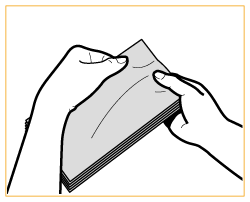
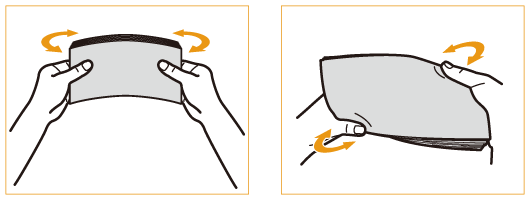
Repeat this step five times for each set of five envelopes.
2
Smooth the envelopes out, and remove any air inside them.
Place the envelopes on a clean and flat surface, and move your hands in the direction of the arrows to remove the air inside the envelopes.
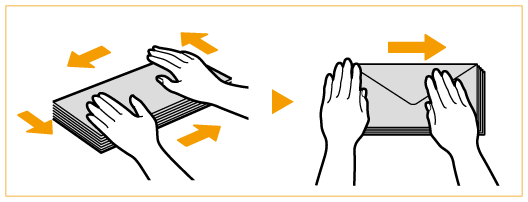
Repeat this step five times for each set of five envelopes.

It is recommended that you use something hard such as a ruler or a pencil to remove curls.
3
Press down on the four sides.
Press down firmly on all four sides. In particular, carefully press down on the side facing the direction in which the envelopes will be fed. Press down firmly so that the flap stays flat.
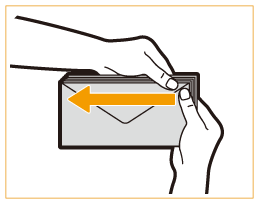

Failure to firmly press down on the flap may result in a paper jam. If this happens, press down firmly on all four sides of each individual envelope.
4
Align the envelopes on a flat surface.
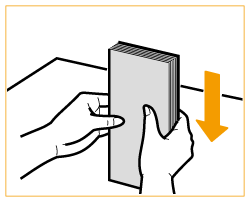

Check that no envelopes are tucked underneath the flap of the envelope above or below them.
Loading the Envelopes in the Paper Drawer (Envelope Feeder Attachment-F)
 |
When you attach the Envelope Feeder Attachment-F to the paper drawer, do not forcefully move the front guide of the paper drawer in the wrong direction. Doing so may detach the Envelope Feeder Attachment-F from the paper drawer. Do not print on both sides of an envelope. Doing so may cause paper jams, dirty prints, or make the inside of the machine dirty. |
 |
For information on envelope that can be loaded to the paper drawer attached the Envelope Feeder Attachment-F, see Available Paper. You can load Kakugata 2 and ISO-5 envelopes into the paper drawer without using the Envelope Feeder Attachment-F. For information on how to load Kakugata 2 and ISO-5 envelopes, see Basic Paper Loading Method and Specifying Paper Size and Type in the Paper Drawer. |
1
Attach the Envelope Feeder Attachment-F to the paper drawer.
 | Prepare the Envelope Feeder Attachment-F. Remove the Envelope Feeder Attachment-F stored in the paper drawer. 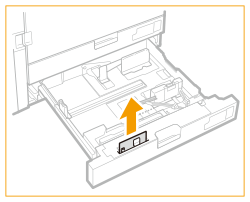 |
 | Attach the Envelope Feeder Attachment-F by aligning the protruding areas of the Envelope Feeder Attachment-F with the holes on paper receptor located on the bottom of the paper drawer. 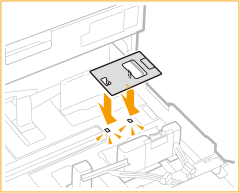 |

When not using the Envelope Feeder Attachment-F, store it in the storage area of the paper drawer.
2
Adjust the position of the paper guides.
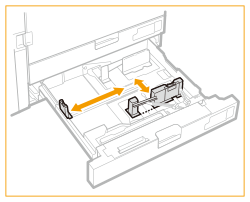
3
Load the envelopes.
Load the envelopes as indicated below, with the front side of the envelopes (the side without the glued areas) face down. Load 50 envelopes at a time.
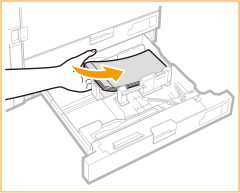
No. 10(COM10), ISO-C5, DL, Monarch, Yougatanaga 3, Yougata 6, Yougata 4, Yougata 2
Close the flaps, and load the envelopes so that their flaps are on the far side.
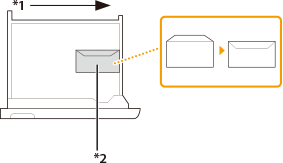
*1 Feeding Direction
*2 Print Side Down
Nagagata 3, Kakugata 2, Nagagata 13, Nagagata 1, Kakugata 8, Kakugata 6, Kakugata 5, Kakugata 3, Kakugata 20, Kakugata 0
Load the envelopes so that their flaps are on the left side.
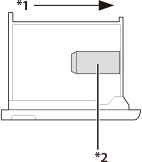
*1 Feeding Direction
*2 Print Side Down
To change the orientation of the envelopes, close the flaps, and load the envelopes so that their flaps are on the right side.
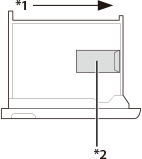
*1 Feeding Direction
*2 Print Side Down

Envelopes may not be able to be fed properly if they are loaded at an angle.
Do not print on the back side (the glued side) of the envelopes.

For Yougatanaga3 made by some envelope manufacturers, do not use "Envelope Feeder Attachment-F" and set it as follows.
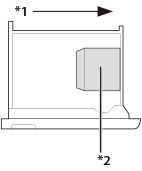
*1 Feeding Direction
*2 Print Side Down
If the envelopes cannot be fed normally, if a paper jam occurs, or if the envelopes become creased, fold the flaps inside the envelopes or rotate the envelopes and load them.

180-degree Rotation
Nagagata 3, Kakugata 2, Nagagata 13, Nagagata 1, Kakugata 8, Kakugata 6, Kakugata 5, Kakugata 3, Kakugata 20, Kakugata 0 | No. 10(COM10), ISO-C5, DL, Monarch, Yougatanaga 3, Yougata 6, Yougata 4, Yougata 2 | |||
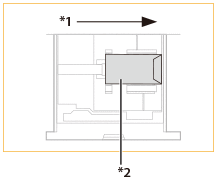 *1 Feeding Direction *2 Print Side Down |  |
90-degree Rotation
If the flap becomes folded or a paper jam occurs with the custom size of 3 7/8" x 5 7/8" to 13" x 19 1/4" (98 x 148 mm to 330.2 x 487.7 mm) | ||
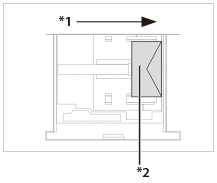 *1 Feeding Direction *2 Print Side Down |
When printing, check that the orientation of the loaded paper matches the orientation shown on the print settings screen of the printer driver. For more information, see the online help.
If you copy on the envelopes, rotate the original before placing it.
If you rotate ISO-C5 by 90 degrees, set 9" x 6 3/8" (229 x 162 mm) by custom size before making an output.
4
Adjust the position of the paper drawer guides.
 | Slide the front guide while squeezing it on the top to align it with the size of a loaded envelope. |
 | Slide the left guide while squeezing it on the top to align it with the size of a loaded envelope. 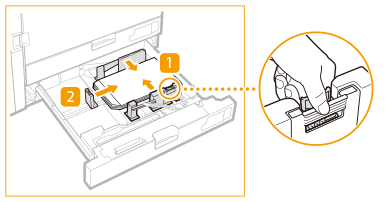 |
 |
Envelopes which have been rolled or curled must be straightened out prior to use. Make sure that the height of the envelope stack does not exceed the height limit mark (  ) )The maximum height (quantity) of envelopes that can be loaded into the cassette is approximately 1 3/8" (33.5 mm). The maximum height (quantity) of envelopes varies, depending on the envelope type and user operating conditions, but as a reference, 1 3/8" (33.5 mm) is approximately 50 envelopes. Check the flat surface of the envelopes when loading them into the paper drawer. If the level of the front edge of the envelopes is higher than that of the back edge, reload the envelopes to make the front edge of the envelopes is even with or lower than the that of the back edge as shown in the illustration below.  *1 Front side of the paper drawer *2 Back side of the paper drawer |
5
Firmly push the paper drawer into the machine.
 |
Envelopes which are curled must be straightened out before loading them into the paper drawer. You will not be able to make copies or print if you load envelopes that exceeds the loading limit mark (  ), or if the paper drawer is not completely pushed into the machine. ), or if the paper drawer is not completely pushed into the machine.Make sure that the height of the envelopes does not exceed the loading limit mark (  ). ).Always check that the paper drawers are in place. Never place paper or any other items in the empty part of the paper drawer. Doing so may cause paper jams. When you are not loading envelopes, make sure to return the Envelope Feeder Attachment-F to its original position. Using the Envelope Feeder Attachment-F for loading paper other than envelopes may cause a paper jam. |
6
Register the type of envelope.
7
Change the paper size label of the paper drawer as necessary.